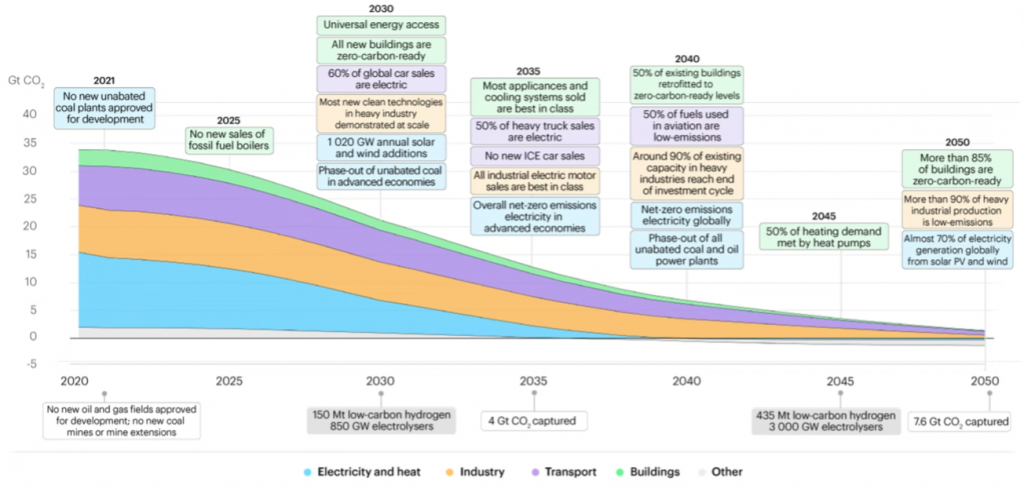Summary
Present climate pledges, even if fully achieved, would fall short to give the world a chance of limiting the global temperature rise to 1.5 °C. Therefore, the world needs to commit on a viable and actionable path to achieve Net-Zero by 2050. While renewables and energy storage are the backbone of the energy transition to achieve Net-Zero by 2050 in the power sector …, the decarbonization of industrial energy demand remains being a technological challenge and lacks an established roadmap.
Present climate pledges, even if fully achieved, would fall short to give the world a chance of limiting the global temperature rise to 1.5 °C
At present, the Net-Zero equation remains unsolved as greenhouse gas (GHG) emissions continue increasing and are not compensated by removals. The world keeps pushing back the year of peak GHG emissions, now forecasted for 2025.
The COP26 meeting held in Glasgow in 2021, focused in improving the pledges made by participating countries so that global temperature does not rise more than 1.5°C above pre-industrial level recorded in the middle of the 19th century. Scientists have concluded that going beyond 1.5°C increases the odds of initiating the most catastrophic impacts of climate change. Even if all Net-Zero commitments and national climate pledges were fulfilled, research suggests that warming would not be held to 1.5°C above preindustrial levels.
Moreover, most of these commitments have yet to be supported by detailed execution plans. Such execution will not be easy, as we must achieve Net-Zero through a path that is compatible with economic development and inclusive growth.
A disorderly transition could impair energy supply and affect energy access and affordability, especially for lower-income households and regions. The 2022 edition of The Energy Progress Report produced by the United Nations, shows that the impacts of the pandemic, including lockdowns, disruptions to global supply chains, and diversion of fiscal resources to keep food and fuel prices affordable, have affected the pace of progress toward ensuring access to affordable, reliable, sustainable and modern energy by 2030. None of these challenges should come as a surprise.
Therefore, the world needs to commit on a viable and actionable path to achieve Net-Zero by 2050
The International Energy Agency (IEA) has defined the Net Zero Emissions by 2050 scenario (NZE) which shows a narrow but achievable pathway for the global energy sector to achieve Net-Zero CO2 emissions by 2050. NZE is a path to achieve Net-Zero while ensuring stable and affordable energy supplies, providing universal energy access, and enabling robust economic growth.
NZE establishes a roadmap (see Figure 1) containing the clear milestones to achieve full decarbonization of electricity by 2050:
- 2030: 1,020 GW annual solar and wind additions and phase-out of unabated coal in advanced economies
- 2035: Overall Net-Zero emissions electricity in advanced economies
- 2040: Net-Zero emissions electricity globally and phase-out of all unabated coal- and oil-fired power plants
- 2050: Almost 70% of electricity generation globally from solar PV and wind

While renewables and energy storage are the backbone of the energy transition to achieve Net-Zero by 2050 in the power sector …
Renewable power deployment as a whole still needs to expand significantly to meet the NZE share of more than 60% of generation by 2030 and 70% by 2050 (being the rest nuclear, and abated fossil fuels through carbon capture, storage and usage). Green generation must increase at a yearly average rate of nearly 12% until 2030, almost twice as much as in the past decade. The rising share of renewables in the power sector poses new challenges and requires to rapidly scaling up energy storage systems to address the hour‐to‐hour variability of wind and solar PV. Meeting rising flexibility needs while decarbonizing electricity generation becomes a central challenge for the power sector.
… the decarbonization of industrial energy demand remains being a technological challenge and lacks an established roadmap
The industry sector accounted in 2020 for 38% and 26% of total global final energy use and GHG global emissions respectively. Renewables just met 11% of the industrial heat demand in 2020, and the NZE trajectory by 2030 establishes the target to double such share by delivering through renewables up to 22% of the projected industrial heat demand.
The pathway to integrating renewable electricity with industrial heat production transits through the development of combined power-to-heat plus thermal storage solutions. The charging equipment options are diverse, including resistance heaters, heat engines, or high temperature heat pumps among others. Likewise, there exist alternative Thermal Energy Storage (TES) technologies depending on the principle used to store the heat: sensible heat (increasing the temperature of a solid or liquid medium), latent heat (changing the phase of a material), or thermochemical heat (underpinning endothermic and exothermic reactions). These technologies use different mediums to store the heat such as molten salts, concrete, metal alloy, or rock material in insulated containers.
The most widespread thermal Long Duration Energy Storage (LDES) technology are molten salts coupled with Concentrated Solar Power (CSP) plants. Nonetheless, molten salts can effectively be used in novel thermal LDES applications to decarbonize other industrial heat generation processes.
At Build to Zero we are devoted to developing a roadmap to efficiently decarbonize industrial heat by designing and building power-to-heat plus thermal energy storage technologies. We develop behind-the-meter (BTM) industrial applications, leveraging our extensive experience in molten salts LDES at CSPs. Our team members have participated in the development of more than 60% of the installed global capacity.
We believe that achieving Net-Zero industrial heat is a massive challenge which can only be addressed through open innovation and collaboration, and that is why we actively share and cooperate with others in multiple international R&D and product development projects.
